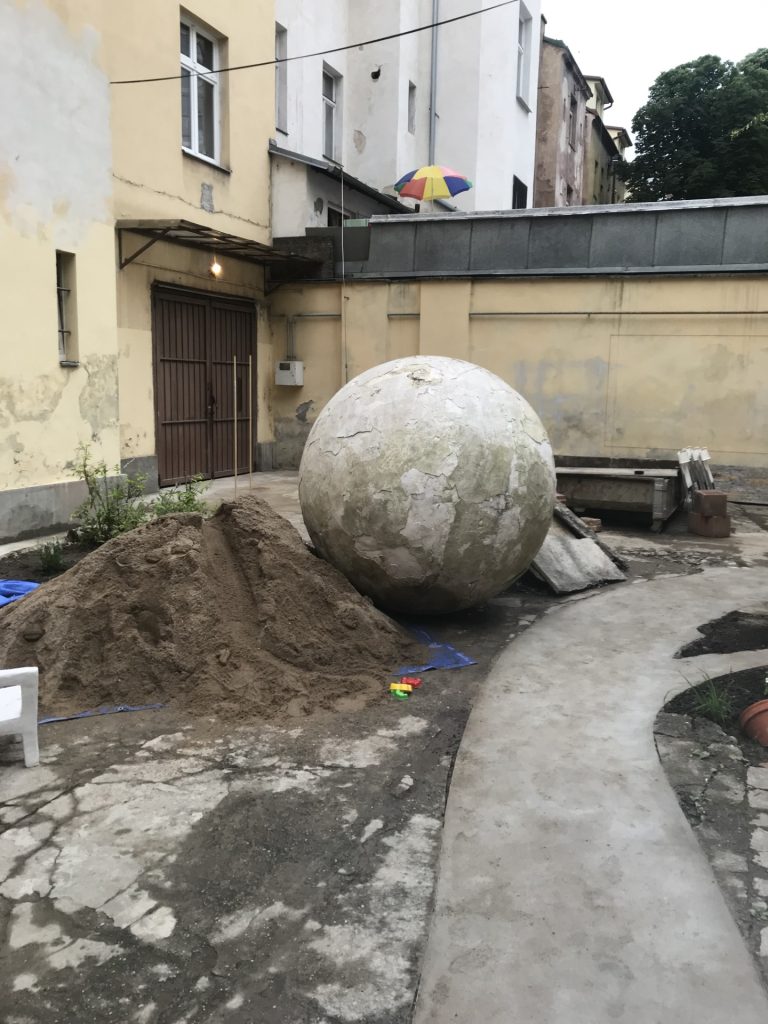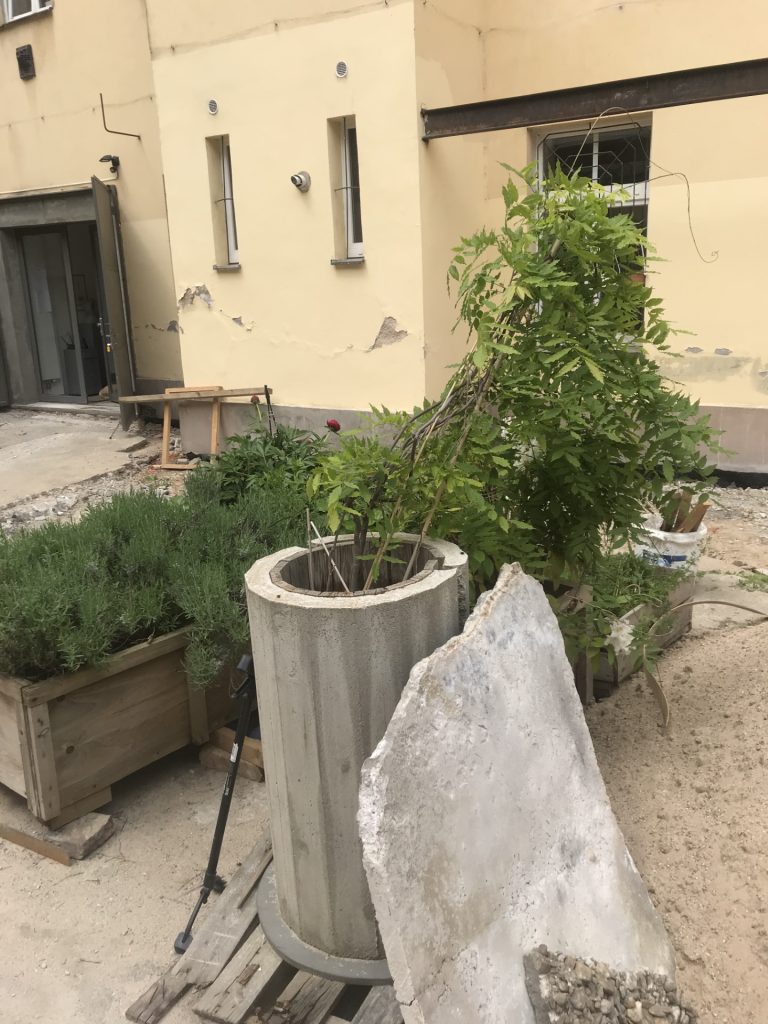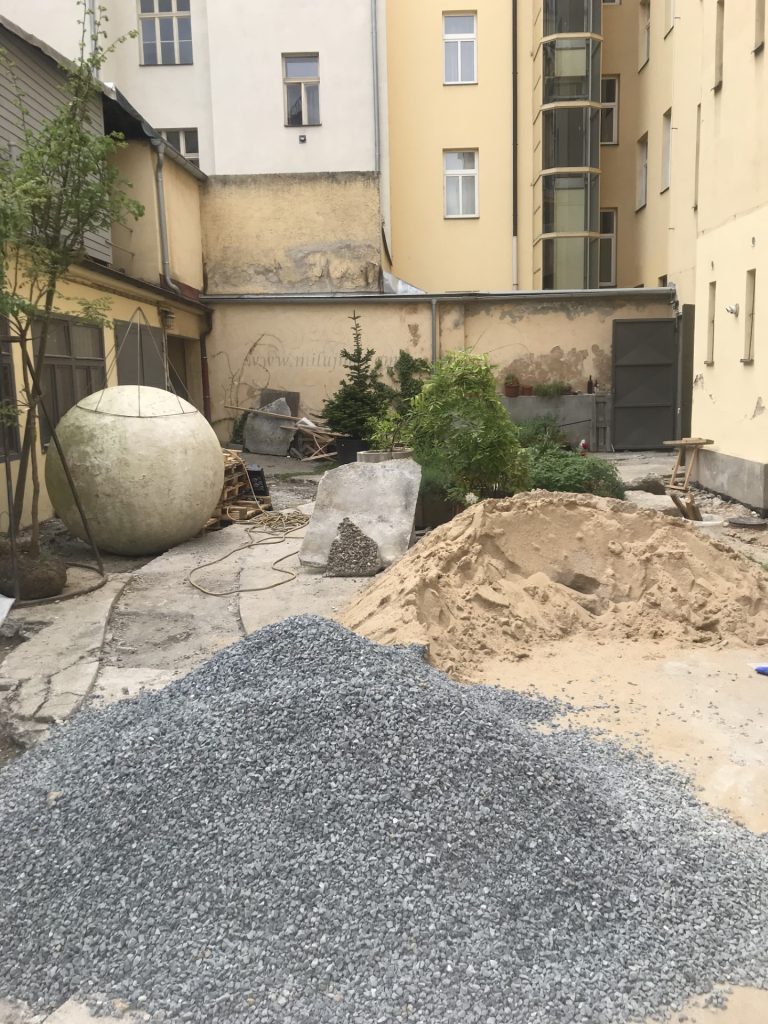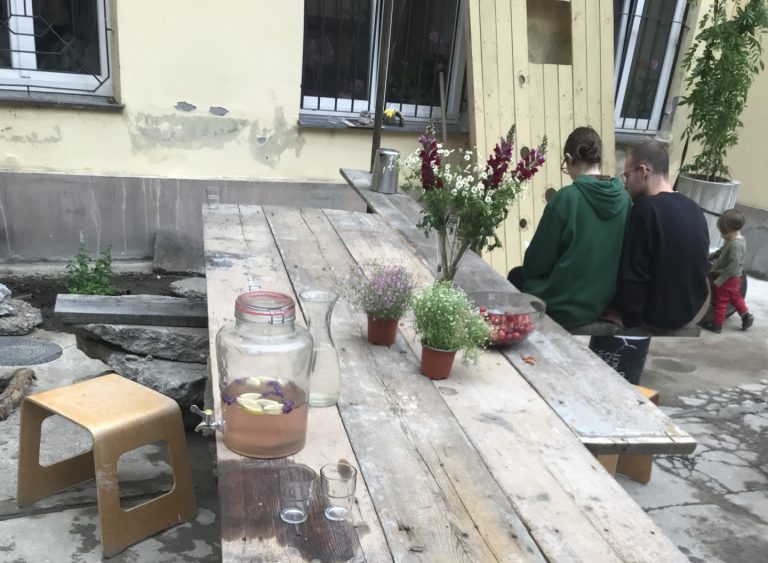Brno Daily’s Ruby Dark reports from a unique new public space in the heart of Zizkov. Photo credit: Ruby Dark.
Both a beginning and a finale at the same time, Domink Lang celebrated his project “Let’s Go Outside, Even If It Rains” at the Hunt Kastner gallery last week. For the past two months, the artist has been permanently transforming the garden space of the gallery. The project was open for the public to view from start to finish, and now, the Hunt Kastner garden will remain open as a public gathering space in the heart of Zizkov.
I first visited the gallery garden on 19 May. Gallery supervisor Anna Sýsová rose from her desk to greet me at the door and give me a tour. We gingerly stepped over a sunbathing dog blocking the doorway to the garden outside.
The courtyard looked more like a building site than a quaint gallery garden; even less like an art exhibition. Piles of rubble filled every corner, sheets of tarp blanketed stacks of materials, and heaps of soil covered broken walkways. A concrete globe leant against one wall of the garden. The space looked like an abstract expressionist demolition yard.
Lang had been deliberately secretive about his plans for the garden. Context was sparse – no gallery text or accompanying pamphlets offered any clues as to the intentions of the artist or what the space would become.
The only suggestion of Lang’s plan was some hand-drawn blueprints stuck to the wall of the interior room in the gallery. The papers were covered in notes, scribbles, numbers and blobs of ink that seemed indecipherable to all but the artist.
The inside space was also home to some artefacts gathered by Lang that hinted at the mystery of the project. A broken jug, a deflated football and blocks of wood guarded the entrance. At the far end of the gallery stood a wall-length table displaying various curios, some looking as if they’d been recovered from an ancient burial site, others as if they’d been picked off the back of a skip outside. A rusted metal grate sat beside a worn doll’s head. A broken vase had been reformed into a 2D puzzle of its original form.
Could these items suggest reformation and regeneration? Symbols of repurposing the old, salvaging the ruined and rebuilding the broken? Only time would tell.
Despite its vagueness, Lang’s project is defined by transparency. Visitors were able to visit the site throughout the project, witnessing the day-by-day transformation, and even seeing the artist at work.
By 23 June, the Hunt Kastner garden had metamorphosed into a lively gathering space, filled with friends and family of the artist and the gallery. Broken walkways had been filled, trailing through the garden. The piles of soil now laid in hand-made garden beds, nourishing plants that Lang had carefully chosen and positioned himself.
The garden still maintained an unfinished quality, though. An unvarnished wooden plank balanced on two piles of rubble was fashioned into a table, adorned with a bowl of cherries and a jug of lavender lemonade. A pile of sand in the middle of the garden suggested that perhaps the team hadn’t quite finished clearing up before visitors arrived (which may be true, Lang was adding finishing touches to the garden 5 minutes before opening time). But with children playing in the sand, building castles and digging tunnels, it looked more like a deliberate feature than unwelcome clutter.



In fact, the whole garden was playground-esque. The space was very much in flux, charged with a kinetic energy, inviting visitors to participate in shaping and reshaping the space. None of the features seemed to be fixed in place. Even the concrete ball, which now sat in the centre of the garden, looked as if it was beckoning me to give it a push, though I wasn’t brave enough to try.
Everything suggested that the metamorphosis was not yet complete, but that from now, there was an open invitation to join in. Anna, the gallery supervisor, shared her hopes for the garden. “I want it to align with whatever the neighbourhood needs. A cafe, a bar, a place to just sit and read, anything. I think it will always be changing.”
The garden defies expectations of what an exhibition should be, and breaks the conventions of who gets to influence gallery space. On the Hunt Kastner website, Lang is quoted as saying “We often think of architecture as something that is given, has some unwritten rules and expectations. I promise myself that this space won’t be like that, but will be as open and welcoming as possible, without moments that define us into some positions, determine a hierarchy or an order.”
Throughout the evening, grey clouds loomed low over the visitors, as if testing our commitment to the projects’ name. Not to worry – Hunt Kastner had planned ahead, sending each guest a raincoat along with their invitation to the opening. But the threat of rain didn’t deter anyone – we stayed outside, exploring, talking, and imagining what the future of the project could hold.








